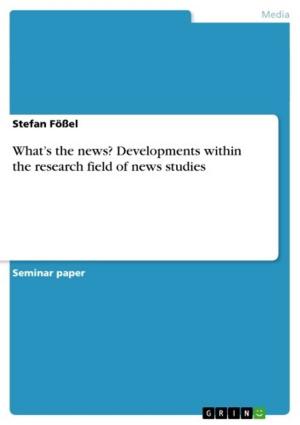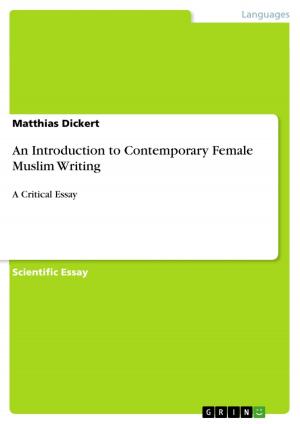James Joyce's 'Finnegans Wake' and the Aesthetics of the Grotesque
Fiction & Literature, Literary Theory & Criticism, British| Author: | Eva Forster | ISBN: | 9783640532902 |
| Publisher: | GRIN Publishing | Publication: | February 10, 2010 |
| Imprint: | GRIN Publishing | Language: | English |
| Author: | Eva Forster |
| ISBN: | 9783640532902 |
| Publisher: | GRIN Publishing |
| Publication: | February 10, 2010 |
| Imprint: | GRIN Publishing |
| Language: | English |
Seminar paper from the year 2006 in the subject English Language and Literature Studies - Literature, grade: 1,0, University of Stuttgart (Literaturwissenschaft), course: Hauptseminar: Modernism, language: English, abstract: James Joyce's Finnegans Wake is one of the notoriously most difficult literary works of modernism, 'supplying scholars, critics and theorists simultaneously with what is both a Pandora's box and a cornucopia of stimulants'. Lacking any kind of traditional concepts of structure, it has an inconsistency and a vagueness that make it hard to pin down a coherent plot or get a definite notion about the characters, who undergo frequent transformations. Of course this 'jungle of woods' (112.4), or 'jumble of words' puts a great strain on the reader who is generally used to a consecutive kind of reading process. Therefore it is not amazing that the early reception of the 'Wake' has been rather hostile, rejecting it at worst as an 'artistic failure'. Derek Attridge sees the major reason for this negative attitude towards the 'Wake' in 'the work's intensive use of the portmanteau word', which destroys the notion of a trustworthy language system, and that of a reliable authorial intention. Yet, the 'carnival of linguistic vivisection' and the numerous transformations are precisely the features of the 'Wake' which grant it its 'humor of the incongruous and the grotesque'. Apparently, Finnegans Wake is not only highly indebted to a sixteenth-century metaphysician and an eighteenth-century philosopher (Giordano Bruno's notion of coinciding opposites and transformation as well as Giambattista Vico's cyclical concept of history are important aspects of Finnegans Wake), but also to a mode of writing which has a centuries-old tradition - the grotesque. A grotesque style of writing was taken up by many modernist authors, such as Franz Kafka, Elias Canetti, or Djuna Barnes, to name only a few. Joyce had already used grotesque features in Ulysses, in which, next to the continuous depiction of the gross physicality of the human body, especially the Circe chapter contains a wide range of grotesques. The aim of this paper is to track down elements of the grotesque in Finnegans Wake. In doing so, the question of grotesque language and the literary representation of the body in the 'Wake' will be of particular interest.Since the term 'grotesque' forms the basis of the paper, the following chapter will give a short overview of this aesthetic mode, focusing on aspects which are important with regard to Finnegans Wake.
Seminar paper from the year 2006 in the subject English Language and Literature Studies - Literature, grade: 1,0, University of Stuttgart (Literaturwissenschaft), course: Hauptseminar: Modernism, language: English, abstract: James Joyce's Finnegans Wake is one of the notoriously most difficult literary works of modernism, 'supplying scholars, critics and theorists simultaneously with what is both a Pandora's box and a cornucopia of stimulants'. Lacking any kind of traditional concepts of structure, it has an inconsistency and a vagueness that make it hard to pin down a coherent plot or get a definite notion about the characters, who undergo frequent transformations. Of course this 'jungle of woods' (112.4), or 'jumble of words' puts a great strain on the reader who is generally used to a consecutive kind of reading process. Therefore it is not amazing that the early reception of the 'Wake' has been rather hostile, rejecting it at worst as an 'artistic failure'. Derek Attridge sees the major reason for this negative attitude towards the 'Wake' in 'the work's intensive use of the portmanteau word', which destroys the notion of a trustworthy language system, and that of a reliable authorial intention. Yet, the 'carnival of linguistic vivisection' and the numerous transformations are precisely the features of the 'Wake' which grant it its 'humor of the incongruous and the grotesque'. Apparently, Finnegans Wake is not only highly indebted to a sixteenth-century metaphysician and an eighteenth-century philosopher (Giordano Bruno's notion of coinciding opposites and transformation as well as Giambattista Vico's cyclical concept of history are important aspects of Finnegans Wake), but also to a mode of writing which has a centuries-old tradition - the grotesque. A grotesque style of writing was taken up by many modernist authors, such as Franz Kafka, Elias Canetti, or Djuna Barnes, to name only a few. Joyce had already used grotesque features in Ulysses, in which, next to the continuous depiction of the gross physicality of the human body, especially the Circe chapter contains a wide range of grotesques. The aim of this paper is to track down elements of the grotesque in Finnegans Wake. In doing so, the question of grotesque language and the literary representation of the body in the 'Wake' will be of particular interest.Since the term 'grotesque' forms the basis of the paper, the following chapter will give a short overview of this aesthetic mode, focusing on aspects which are important with regard to Finnegans Wake.















